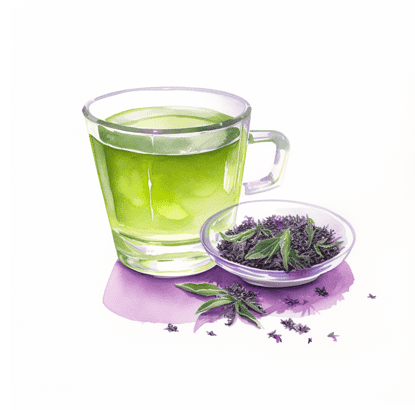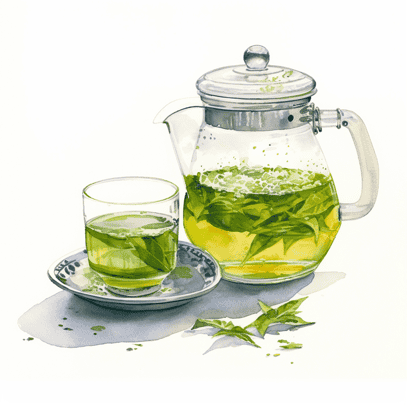
Discover the health benefits of Sencha green tea, a powerhouse of nutrients that rejuvenates your skin and boosts overall wellness. Dive into how this remarkable Japanese brew can transform your health and beauty regimen.
Hi, I’m Hazel
I gave up on skincare after years of issues with acne and sensitive skin.
But after going plant-based, my skin cleared up and even started to glow. Now I help women reveal their natural beauty with simple, delicious plant-based food.
I also used to be a nurse, and love nerding out on nutritional science (high-quality science, that is).

As usual, this post is based on the strongest nutritional evidence I could find with a focus on the simplest, most delicious foods
…because who has time to waste on actions that don’t work?
The quick version:
The health benefits of Sencha green tea including being a powerhouse for skin health, enhancing hydration and smoothness while protecting against UV damage with its high levels of epigallocatechin gallate (EGCG).
Beyond skincare, it boosts metabolism, supports heart health, and strengthens the immune system, making it a comprehensive choice for overall wellness.
Sencha Green Tea
This japanese green tea originates from the esteemed camellia sinensis plant and is cultivated with a distinct method that fully exposes the tea leaves to direct sunlight.

This exposure enhances the tea’s nutritional profile, making it richer in powerful antioxidants like epigallocatechin gallate (EGCG) compared to other Japanese tea types. Unlike black tea or Chinese tea, sencha offers a unique taste and a higher antioxidant content, positioning it as a top contender among the most popular green teas.
Whether you’re sipping a cup of sencha tea for relaxation or integrating it into your skincare routine, its benefits are as profound as its roots in Japanese culture.
Skincare Benefits
Sencha tea cares for your skin in multiple ways:
With Luscious Antioxidants
- Sencha green tea boasts a rich blend of antioxidants, including vitamin C and epigallocatechin gallate (EGCG) to reduce oxidative stress and inflammation (1).
- Protects against UV rays and fights free radicals, reducing fine lines and pigmented facial spots (2,3).
- Enhances skin hydration and smoothness, promoting a radiant glow (2).

Acne Reduction and Elasticity Improvement
- EGCG reduces sebum production and inflammation, significantly decreasing acne (4).
- Regular application of green tea lotion can halve the amount of pimples (5).
- Increases skin elasticity within 8 weeks, although changes may not be visible to the naked eye (6).
Cellular Health and DNA Repair
- Facilitates DNA repair, with increased activity from just one cup of sencha tea (7).
- Drinking two cups a day enhances DNA repair further (8).
- Long-term consumption (four cups a day for five months) helps in lengthening telomeres, indicators of cellular health and ageing (9).
Making the Most of Your Tea
To fully harness the health and skincare benefits of sencha green tea, it’s crucial to brew it correctly. Heat water to 90 degrees Celsius—this optimal temperature helps preserve the delicate antioxidant content of the tea (10). By maintaining this specific heat, each cup of sencha tea remains potent, ensuring you receive the maximum benefits with every sip.
You may also like:
Sencha vs. Matcha: Which Green Tea is Right for You?
Weight Management Benefits
Sencha green tea may also aid in weight loss. The key lies in its high levels of green tea catechins, specifically EGCG, which boost metabolic rates and increase fat oxidation.

- Boosting Metabolism: The catechins in sencha green tea help raise metabolic rates temporarily, making it easier for your body to burn fat. This is a natural way to support weight management without the harsh effects of chemical stimulants.
- Regulating Blood Sugar Levels: Sencha is effective in blunting the glycemic response, especially when consumed with meals (11). This can be particularly beneficial after consuming high-carbohydrate foods like white bread. The tea helps block the transport of sugars through the intestinal wall, improving overall blood sugar control.
- Enhanced Fat Burning: A study highlighted that a group consuming green tea with their meals lost significantly more weight—around 10 pounds on average—compared to those who didn’t, despite consuming the same amount of calories (12).
Recommendation for Consumption
To harness these benefits, incorporating about two to three cups of green tea daily could be effective. Especially when consumed around meal times to optimise the metabolic and glycemic benefits.
By integrating senchainto your daily routine, particularly near meal times and in conjunction with a balanced diet, you can enjoy a delicious and natural option for managing weight and enhancing overall health.
You might also like:
From Fresh to Foul: How Long Does Green Tea Last?
Other Health Benefits
The health benefits of sencha green tea extend beyond your skin and metabolism; it’s also a champion for your overall health.
For example, green tea consumption strengthens the immune system (14).

Regular intake of Sencha may help manage cholesterol levels and reduce the risk of heart disease (15, 16). Its natural compounds also help reduce high blood pressure (17).
The anti-cancer properties of sencha, attributed to its rich green tea polyphenols, are pivotal in preventing various types of cancer (18).
Therefore Incorporating a few cups of green tea into your daily regimen could be a simple yet effective strategy to enhance your heart health and guard against serious health issues.
Mental and Emotional Wellbeing
Finally, Sencha green tea contains less caffeine than black tea, making it an excellent choice for enhancing mental clarity without overstimulation.

The green tea polyphenols in sencha, particularly theanine, are known for their calming effects and ability to enhance brain function (19).
This can help reduce stress and improve mental focus. This makes sencha an ideal beverage for those busy days when you need to stay sharp and serene.
Integrating Sencha into Your Lifestyle

Adopting sencha green tea into a daily routine will improve your life in more ways than one. Here are some tips to make that journey easier:
For Enhanced Mental Clarity
Sip a cup of sencha tea in the morning. The moderate caffeine content kickstarts your day without the jitters, improving focus and alertness.
For Skin Health and Antioxidant Boost
Enjoy sencha mid-morning or early afternoon. This timing allows the powerful antioxidants, like EGCG, to combat free radicals and support skin health throughout the day.
For Relaxation and Stress Reduction
Drink sencha in the late afternoon or early evening. The calming effects of theanine help soothe the mind and unwind after a busy day.
For Metabolic Boost
Consume sencha with meals or shortly after eating to enhance digestion and help regulate blood sugar levels.
The Best Way to Brew
For the best health benefits and flavour from each cup of sencha tea, it’s crucial to brew it properly.
Use hot water, around 85 degrees Celsius and steep the tea leaves for at least 3 minutes to maintain the integrity of flavours and nutrients. The longer, the better (20).This careful preparation ensures you enjoy every sip while maximising sencha’s healthful properties.
Whether as a morning energiser or an evening soother, integrating sencha into your routine can significantly uplift your overall well-being.
Types and Varieties
Exploring sencha green tea further, we find fascinating varieties like organic sencha tea, asamuchi sencha, and fukamushi sencha. Each type offers a unique twist on the classic sencha flavour and antioxidant properties.
Asamuchi sencha, lighter in flavour, is perfect for those new to green teas, while fukamushi sencha undergoes a deeper steaming process, enriching its flavour and increasing its health-promoting qualities.
Choosing the right type of tea can enhance your experience, ensuring you reap all the health benefits of the tea.
How is Sencha Different from Regular Green Tea?
“Regular” green tea, while a broad term, generally refers to the basic method of processing green tea leaves which is used across various regions, particularly in China.
Green tea preparation
Here’s a general outline of how “regular” green tea is typically prepared:
- Harvesting: The tea leaves are picked from the Camellia sinensis plant. The age and part of the plant from which the leaves are harvested can vary, affecting the flavour and quality of the tea.
- Withering: After harvesting, the leaves are typically left to wither slightly to reduce moisture content.
- Steaming or Pan-firing: To prevent oxidation (which turns green tea into black tea), the leaves are quickly heated. Chinese green teas are often pan-fired (roasted in a pan), which gives them a slightly toasted flavour. Some other green teas are steamed, which keeps the flavour more vegetal and fresh.
- Rolling: The leaves are then rolled to form various shapes. This process also breaks down the cells in the leaves, enhancing flavour release.
- Drying: Finally, the tea leaves are dried to lock in the flavours and prepare them for storage.
Sencha preparation
- Steaming Method: Unlike the more common pan-firing used in many Chinese green teas, sencha is prepared by steaming the leaves. This steaming process is relatively quick and done at high temperatures, stopping the oxidation process almost immediately. This preserves the rich green colour and results in a fresher, grassier taste and a finer aroma compared to the often nuttier or more roasted flavours of pan-fired green teas.
- Rolling: After steaming, sencha leaves are rolled into tight cylinders. This is a distinctive Japanese technique different from the various rolling or pressing methods used in Chinese green teas, which might result in flat or twisted leaves depending on the type.
- Flavour and Texture: Due to the steaming process, sencha tends to have a more delicate, vegetal flavour with a slightly sweet undertone and less bitterness than many Chinese green teas. The texture is also smoother, and the colour of the brewed tea is a vibrant green.
- Caffeine and Nutrient Retention: The steaming process used in sencha preparation helps to retain more of the natural caffeine and antioxidants, particularly EGCG, compared to some other methods which can degrade some of these elements.
These distinctive steps highlight how sencha is not just another type of green tea but a unique variety with specific qualities favoured by many tea enthusiasts worldwide.
Health benefits of sencha green tea
Sencha green tea is much more than a mere beverage; it’s a potent elixir that offers a myriad of health benefits of sencha green tea. From enhancing your skin’s health and appearance with it’s high concentration of antioxidants to improving mental clarity and supporting heart health and cancer prevention, sencha has proven itself as a valuable part of a health-conscious lifestyle. By making sencha green tea a regular part of your daily routine, you’re not just enjoying a delicious cup of tea; you’re investing in your long-term health and wellness. Embrace sencha’s full potential and let it guide you to a healthier, more vibrant life.
References
Most references below will link to the original peer-reviewed study itself. However, sometimes I will link to a video over at NutritionFacts.org instead, which is by far the single best resource of brutally transparent nutritional evidence you will ever see. Dr Greger tells a great story about the realities of the science and if I think you will benefit more from one of his videos, the link will take you there instead.
Happy nerding!
- Hasegawa N, Niimi N, Odani F. Vitamin C is one of the lipolytic substances in green tea. Phytother Res. 2002;16 Suppl 1:S91-S92. doi:10.1002/ptr.843
- Heinrich U, Moore CE, De Spirt S, Tronnier H, Stahl W. Green tea polyphenols provide photoprotection, increase microcirculation, and modulate skin properties of women. J Nutr. 2011;141(6):1202-1208. doi:10.3945/jn.110.136465
- Fukushima Y, Takahashi Y, Kishimoto Y, et al. Consumption of Polyphenols in Coffee and Green Tea Alleviates Skin Photoaging in Healthy Japanese Women. Clin Cosmet Investig Dermatol. 2020;13:165-172. Published 2020 Feb 10. doi:10.2147/CCID.S225043
- Yoon JY, Kwon HH, Min SU, Thiboutot DM, Suh DH. Epigallocatechin-3-gallate improves acne in humans by modulating intracellular molecular targets and inhibiting P. acnes. J Invest Dermatol. 2013;133(2):429-440. doi:10.1038/jid.2012.292
- Van Aller GS, Carson JD, Tang W, et al. Epigallocatechin gallate (EGCG), a major component of green tea, is a dual phosphoinositide-3-kinase/mTOR inhibitor. Biochem Biophys Res Commun. 2011;406(2):194-199. doi:10.1016/j.bbrc.2011.02.010
- Chiu AE, Chan JL, Kern DG, Kohler S, Rehmus WE, Kimball AB. Double-blinded, placebo-controlled trial of green tea extracts in the clinical and histologic appearance of photoaging skin. Dermatol Surg. 2005;31(7 Pt 2):855-860. doi:10.1111/j.1524-4725.2005.31731
- Ho CK, Choi SW, Siu PM, Benzie IF. Effects of single dose and regular intake of green tea (Camellia sinensis) on DNA damage, DNA repair, and heme oxygenase-1 expression in a randomized controlled human supplementation study. Mol Nutr Food Res. 2014;58(6):1379-1383. doi:10.1002/mnfr.201300751Ho CK, Choi SW, Siu PM, Benzie IF. Effects of single dose and regular intake of green tea (Camellia sinensis) on DNA damage, DNA repair, and heme oxygenase-1 expression in a randomized controlled human supplementation study. Mol Nutr Food Res. 2014;58(6):1379-1383. doi:10.1002/mnfr.201300751
- Ho CK, Choi SW, Siu PM, Benzie IF. Effects of single dose and regular intake of green tea (Camellia sinensis) on DNA damage, DNA repair, and heme oxygenase-1 expression in a randomized controlled human supplementation study. Mol Nutr Food Res. 2014;58(6):1379-1383. doi:10.1002/mnfr.201300751
- Hovanloo, F. & Fallah Huseini, Hasan & Hedayati, Mehdi & Teimourian, Mostafa. (2016). Effects of Aerobic Training Combined with Green Tea Extract on Leukocyte Telomere Length, Quality of Life and Body Composition in Elderly Women. Journal of Medicinal Plants. 15. 47-57.
- Jakubczyk K, Kochman J, Kwiatkowska A, et al. Antioxidant Properties and Nutritional Composition of Matcha Green Tea. Foods. 2020;9(4):483. Published 2020 Apr 12. doi:10.3390/foods9040483
- Villa-Rodriguez JA, Aydin E, Gauer JS, Pyner A, Williamson G, Kerimi A. Green and Chamomile Teas, but not Acarbose, Attenuate Glucose and Fructose Transport via Inhibition of GLUT2 and GLUT5. Mol Nutr Food Res. 2017;61(12):10.1002/mnfr.201700566. doi:10.1002/mnfr.201700566
- Auvichayapat P, Prapochanung M, Tunkamnerdthai O, et al. Effectiveness of green tea on weight reduction in obese Thais: A randomized, controlled trial. Physiol Behav. 2008;93(3):486-491. doi:10.1016/j.physbeh.2007.10.009
- Dinh TC, Thi Phuong TN, Minh LB, et al. The effects of green tea on lipid metabolism and its potential applications for obesity and related metabolic disorders – An existing update. Diabetes Metab Syndr. 2019;13(2):1667-1673. doi:10.1016/j.dsx.2019.03.021
- Matsumoto K, Yamada H, Takuma N, Niino H, Sagesaka YM. Effects of green tea catechins and theanine on preventing influenza infection among healthcare workers: a randomized controlled trial. BMC Complement Altern Med. 2011;11:15. Published 2011 Feb 21. doi:10.1186/1472-6882-11-15
- Ohishi T, Goto S, Monira P, Isemura M, Nakamura Y. Anti-inflammatory Action of Green Tea. Antiinflamm Antiallergy Agents Med Chem. 2016;15(2):74-90. doi:10.2174/1871523015666160915154443
- Xu R, Yang K, Li S, Dai M, Chen G. Effect of green tea consumption on blood lipids: a systematic review and meta-analysis of randomized controlled trials. Nutr J. 2020;19(1):48. Published 2020 May 20. doi:10.1186/s12937-020-00557-5
- Khalesi S, Sun J, Buys N, Jamshidi A, Nikbakht-Nasrabadi E, Khosravi-Boroujeni H. Green tea catechins and blood pressure: a systematic review and meta-analysis of randomised controlled trials. Eur J Nutr. 2014;53(6):1299-1311. doi:10.1007/s00394-014-0720-1
- Lu X, Saeed MEM, Hegazy MF, Kampf CJ, Efferth T. Chemopreventive Property of Sencha Tea Extracts towards Sensitive and Multidrug-Resistant Leukemia and Multiple Myeloma Cells. Biomolecules. 2020;10(7):1000. Published 2020 Jul 4. doi:10.3390/biom10071000
- Video: Dietary Wave Alteration at NutritionFacts.org
- Winiarska-Mieczan, A. and Baranowska-Wójcik, E. (2024). The Effect of Brewing Time on the Antioxidant Activity of Tea Infusions. Applied Sciences, [online] 14(5), p.2014. doi:https://doi.org/10.3390/app14052014.